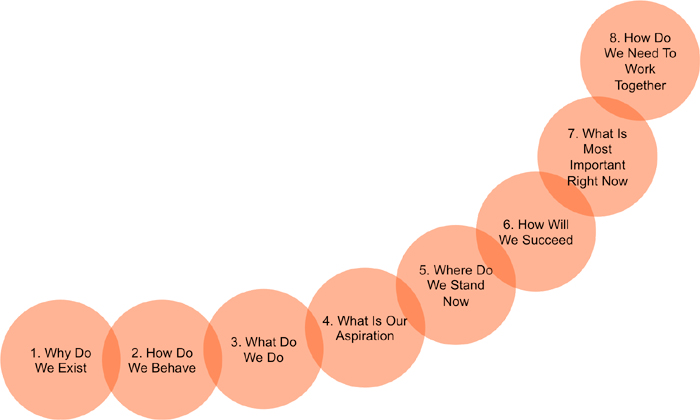During a strategy session I facilitated recently I asked a senior executive team how well aligned they thought they were. They answered pretty positively saying that they had done a budget session only a few months ago and all were clear about the company’s priorities. The CEO went one step further saying that we not only have clarity regarding strategy in this room but also the rest of the organisation as well.
If you’re curious about really getting your team aligned, download “Fully Align You Leadership Team by Asking and Answering 8 Smart Questions.” But continuing about this confident CEO, I decided to challenge them and do the alignment test and asked them to write down the top 3 strategic priorities of the company. The result: I got 15 different strategic priorities out of a maximum of 24, implying that they were only 50% aligned. The calculation follows as:
(Actual number of answers (15) – Minimum number of answers (3))
/ Maximum number of answers (24) = .5
Needless to say, an awkward silence was followed by a heated debate surrounding the topic.
I was called into this meeting to help the leadership team identify, create alignment and build a rational and emotional commitment to their 5 year strategic plan. It’s one of my signature programs and I was excited to guide the team to create a one page strategy and convert it into an action plan that captured not only the purpose, vision, values and aspiration of the company but also the strategic Must Win Battles on how to achieve it.
Lencioni’s 6 Questions
In developing this program, I have taken a lot of inspiration from Patrick Lencioni who in his book The Advantage identifies 6 simple critical questions that leaders need to answer to provide clarity regarding the direction of the company for all its employees. None of these questions are ground breaking in their own right but the difference in Lencioni’s view is the realization that they can’t be addressed isolation and must be answered together. The answers need to be discussed and agreed between the leadership team members so that they are not only behind the answers but also behind the consequences of each one .
The six questions for Lencioni are:
- Why Do We Exist?
- How Do We Behave?
- What Do We Do?
- How Will We Succeed?
- What Is Important Right Now?
- Who Must Do What?
Over the years while working with numerous organisation on identifying, aligning and creating a commitment to the strategic agenda of the company I have added two additional questions.
The Missing 2 Questions
Firstly I have learned that although the ‘Why Do We Exist?’ helps create a burning ambition in people and ensures that what the change leaders want to implement is sustainable and driven by their collective personal vision, it doesn’t always provide a rallying cry to galvanize the larger organisation. For this purpose I have added an element in which the leadership team not only talks about its purpose and vision but also articulates their aspirational goal. A 5 year goal that creates stretch, awe, urgency and a realization that we can’t achieve this objective by continuing to do things the same way as we have in the past.
Similarly I have learned that the answers to ‘How We Will Succeed?’ are dependent on how the leadership team members assess their current reality. In most teams it’s not only a disagreement on ‘where do we need to go?’ and ‘how will we get there?’ but also on ‘where do we stand today?’. Getting all team members to agree on the current status of the organisation across functional, divisional or business unit (power) lines is a strong exercise by itself. It requires teams to give up their domain to a collective assessment of the value they add to the business.
Over the years I have added these components to Lencioni’s ‘famous 6’ and developed a program that facilitates team members through a number of exercises to answer the following 8 critical questions:

The impact of organisational success will be gi-normous if leaders are able to jointly articulate the answers to these questions, share the consequences and explain how each and every employees can contribute to this strategy.
Over the next few weeks I’ll explain step by step how as a CEO or leader you can help your leadership team to debate, argue, discuss and come to a common and shared answer to these questions. The journey will begin with The Mission and Vision Statements.




[…] week I shared the basic principles of a Strategy Alignment Process that I use to guide leadership teams to create a 1-page strategy which gets converted into an […]
[…] weeks and last week I went into the details of how the Mission and Vision come into play. In the 8 Questions for achieving Team Alignment, this topic covers question 4. It’s right in the middle of your journey as a leader to get your […]
[…] your strategy. Having spoken about knowing where you come from, where you currently stand and where you want to go, it’s finally time to discuss how to get […]
[…] Jointly articulated a purpose that is meaningful, inspires and is important for the organization (for inspiration look at AirBnB’s beautiful new purpose) […]
[…] Related: Read this for insight into activities and tools for strategically aligning your top teams: The Questions You Didn’t Know to Ask for Achieving Team Alignment. […]
[…] So one thing you should do before January is over is to make sure you put all your team members in one room and take them through a process to collectively articulate your strategic priorities for the year and a ‘strategy story’ that you could communicate to the rest of the organisation. Not sure how to get started? Learn the Right Questions to Ask to Achieve Team Alignment. […]